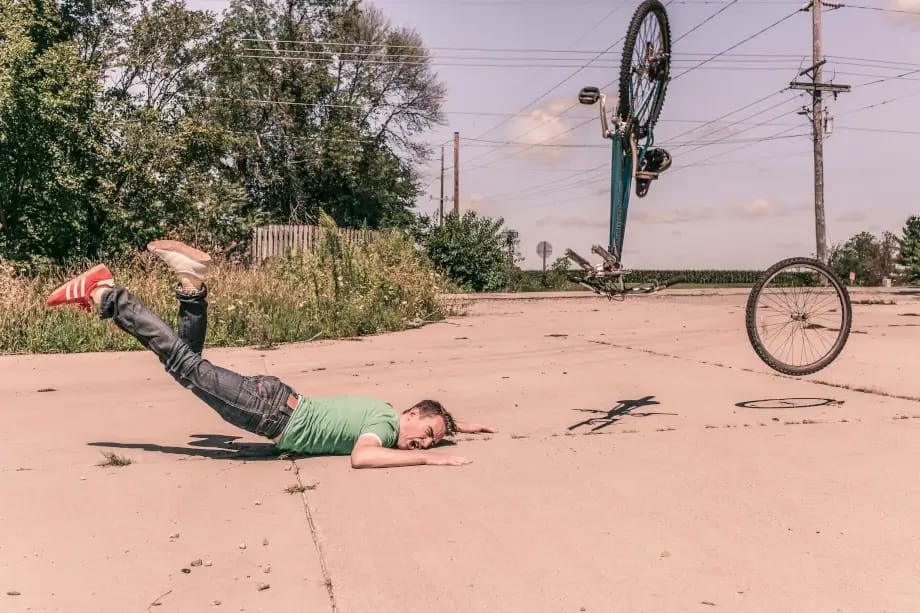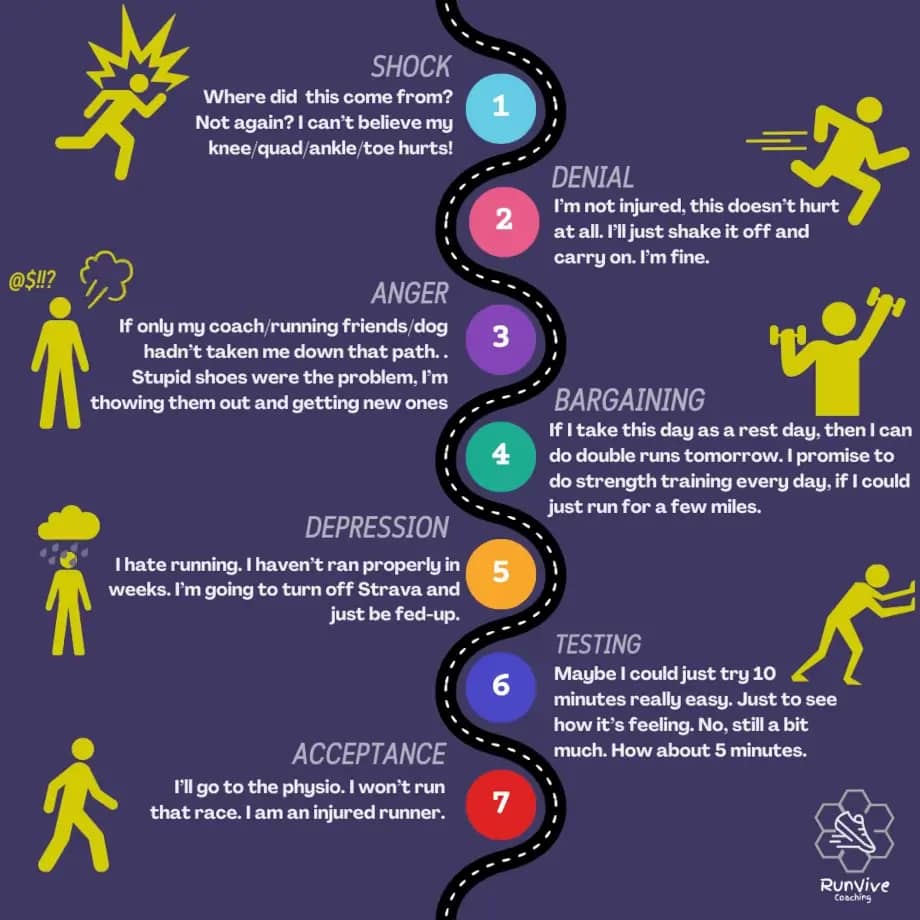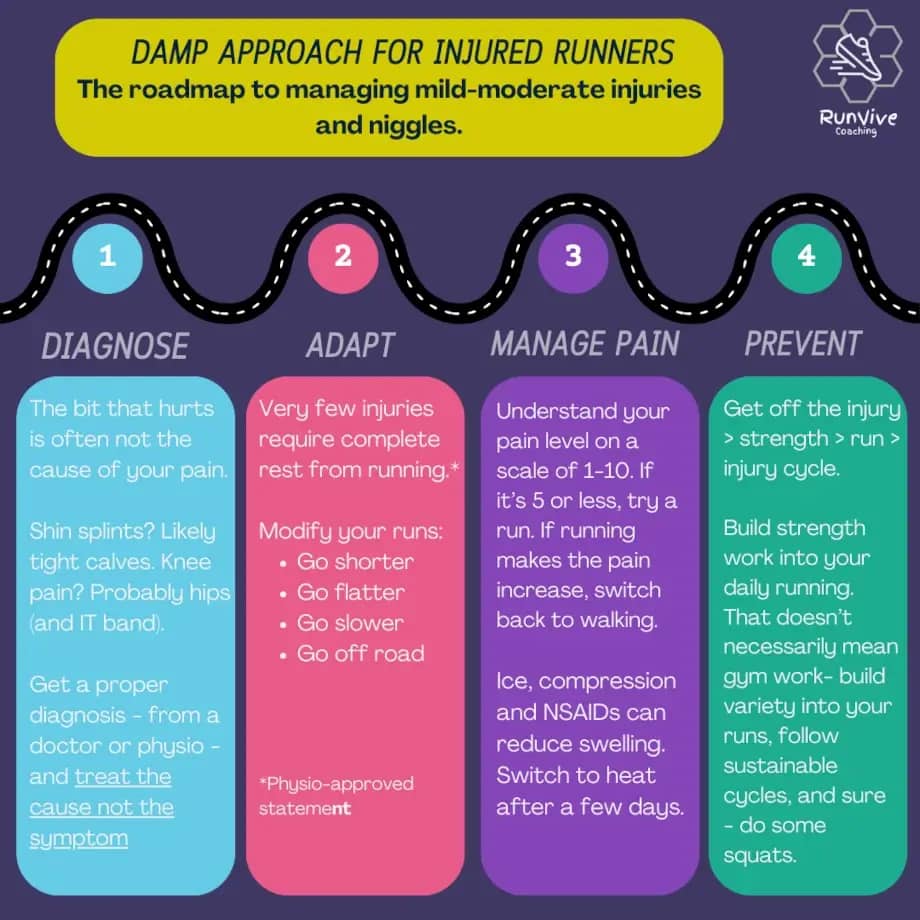
Injured runners are no fun to be around. Slightly less volatile than a tapering runner, but much more irritating than a compliant runner whose just finished their long run, an injured runner is fed up, in pain and grumpy.
No-one likes being injured and injury prevention is a core part of my training philosophy. As runners, we normalise niggles as an accepted part of being a runner; but running with pain does not, and should not be, a normal state of affairs. Variety, strength work, cut back weeks and gradual building are all vital components of sustainable training which reduce the risk of injury.
Yet injuries do of course happen. They can happen through acute injury, where we step off a kerb awkwardly or trip over a root, or they can happen gradually, through asking our body to do too much in the wrong way. In either case, for a lot of regular runners, managing an injury looks a lot like the seven stages of grief:

Accepting you are “an injured runner” is thus the first step in managing any injury. For those without a coach, the second is usually turning to Google or your running club friends and self-diagnosing the issue. Most of the advice you’ll receive broadly follows the same pattern: rest, ice/compress, do stretching exercises for the bit the hurts. Repeat.
BUT. This isn’t the solution.
I completely understand why most online authors do say that – heck, I’m nervous about writing this article for the very same reasons. I don’t know who is reading what I’m about to say; I don’t know if they’ll follow my advice and make their injury worse because they were dealing with a more serious injury than first thought. Rest is safe. Ice is safe. Stretching feels proactive.
But the truth is that, in almost all instances of mild-moderate injuries rest > ice > stretch is not the solution. The body needs to move; ice only helps when there is swelling, and stretching without strengthening is likely to work overused muscles even more.
That’s not to say carry on as you are, running yourself into the ground. Far from it. But adopting a pragmatic approach using the acronym DAMP can help keep you running while healing.

The model only works with a good D. If you’ve had the issue before, such as reoccurring shin splints, you may be able to self-diagnose. But otherwise, get to a physio, a doctor, someone with more medical knowledge than late night Google searching, and understand exactly where the problem is. Because the wonderfully exciting thing about the human body, is that the cause of the problem is likely not where it hurts. So, focusing on the painful area will not treat the problem itself. A diagnosis will help you understand where you need to prioritise stretching and strengthening work, in the right areas.
A lot of runners are going to be delighted with me that they can carry on running; and most of the time you can – if you adapt your running. Slow down, do less miles, find somewhere flat, head to the trails for softer surfaces, use run/walk. For those who run for mental health, you can still carve out that slot, but make sure you’re in tune with your body and be honest with yourself around pain…
… because managing pain is your test as to how much and when. Use the scale 1-10; if anything becomes a 6/10 on the pain scale, stop. Cut your run short, go home. When you get home, use that extra time to be proactive – if you have swelling, put some ice on it and use NSAIDs where needed. When the swelling has gone down, switch to heat. Management of pain is an ongoing process, not just required with the initial shock. Let it guide you.
Finally, the most important one. Get off the doom cycle of injury > strength work > run > injury. Embed strength, flexibility, power movements into your training. A varied plan will do a lot of this but use bodyweight and weighted exercises when you’re feeling strong, not just as an injury rehab tool.
Running is a unilateral movement – one dimensional. We draw on our big muscles, our quads, hamstrings and calves, and rely on the little ones which hold us up to keep working in the kinetic chain. When we neglect the little ones, the big ones either take over or suffer too much load. Our delicate system of sinews, tendons, muscles become overloaded in surprising ways. Equally, while we may feel aggrieved when a root, rock, dog on retractable lead jumps up and surprises us, our ability to react and respond to our environment can be enhanced by working on our ABCs, our agility, balance and coordination. I.e., back to the whole training pyramid and not just running.
Injury-proofing doesn’t just keep you on the road (or trail), it is a vital part of being a stronger and faster runner.
Postscript
Managing niggles and preventing injury are one of the main reasons runners choose to work with a coach. While many are not medically qualified (myself included), we do have a raft of tricks and exercises up our sleeves to explore where there are imbalances and weaknesses. Not enough of us though are trained in strength and conditioning. As a result, I’m heading back to school this week to start a level 3 Strength and Conditioning course, so I can help more runners off the doom loop spiral.


